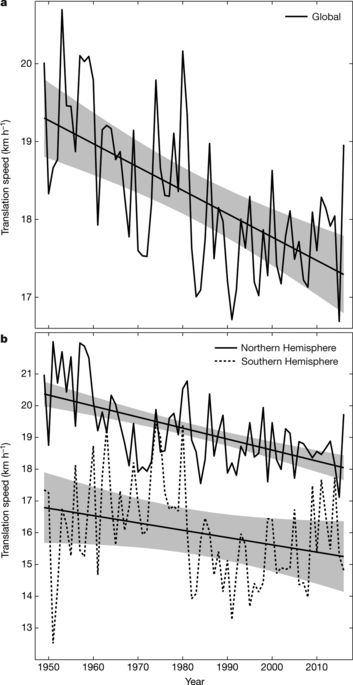Our official English website, www.x-mol.net, welcomes your
feedback! (Note: you will need to create a separate account there.)
A global slowdown of tropical-cyclone translation speed
Nature ( IF 50.5 ) Pub Date : 2018-06-01 , DOI: 10.1038/s41586-018-0158-3 James P Kossin 1
Nature ( IF 50.5 ) Pub Date : 2018-06-01 , DOI: 10.1038/s41586-018-0158-3 James P Kossin 1
Affiliation

|
As the Earth’s atmosphere warms, the atmospheric circulation changes. These changes vary by region and time of year, but there is evidence that anthropogenic warming causes a general weakening of summertime tropical circulation1–8. Because tropical cyclones are carried along within their ambient environmental wind, there is a plausible a priori expectation that the translation speed of tropical cyclones has slowed with warming. In addition to circulation changes, anthropogenic warming causes increases in atmospheric water-vapour capacity, which are generally expected to increase precipitation rates9. Rain rates near the centres of tropical cyclones are also expected to increase with increasing global temperatures10–12. The amount of tropical-cyclone-related rainfall that any given local area will experience is proportional to the rain rates and inversely proportional to the translation speeds of tropical cyclones. Here I show that tropical-cyclone translation speed has decreased globally by 10 per cent over the period 1949–2016, which is very likely to have compounded, and possibly dominated, any increases in local rainfall totals that may have occurred as a result of increased tropical-cyclone rain rates. The magnitude of the slowdown varies substantially by region and by latitude, but is generally consistent with expected changes in atmospheric circulation forced by anthropogenic emissions. Of particular importance is the slowdown of 21 per cent and 16 per cent over land areas affected by western North Pacific and North Atlantic tropical cyclones, respectively, and the slowdown of 22 per cent over land areas in the Australian region. The unprecedented rainfall totals associated with the ‘stall’ of Hurricane Harvey13–15 over Texas in 2017 provide a notable example of the relationship between regional rainfall amounts and tropical-cyclone translation speed. Any systematic past or future change in the translation speed of tropical cyclones, particularly over land, is therefore highly relevant when considering potential changes in local rainfall totals.The translation speed of tropical cyclones has decreased globally by 10% over the past 70 years, compounding the increases in cyclone-related local rainfall that have resulted from anthropogenic warming.
中文翻译:

全球热带气旋转换速度放缓
随着地球大气变暖,大气环流发生变化。这些变化因地区和一年中的时间而异,但有证据表明,人为变暖导致夏季热带环流普遍减弱1-8。由于热带气旋是在其周围环境风中携带的,因此有一种合理的先验预期,即热带气旋的平移速度随着变暖而减慢。除了环流变化之外,人为变暖还会导致大气水汽容量增加,这通常会增加降水率 9。热带气旋中心附近的降雨率预计也会随着全球气温升高而增加 10-12。任何特定地区将经历的与热带气旋相关的降雨量与降雨率成正比,与热带气旋的平移速度成反比。在这里,我表明,在 1949 年至 2016 年期间,全球热带气旋的平移速度下降了 10%,这很可能加剧了当地降雨总量的增加,并且可能占主导地位。热带气旋降雨率。放缓的幅度因地区和纬度而异,但总体上与人为排放迫使大气环流的预期变化一致。特别重要的是,受北太平洋西部和北大西洋热带气旋影响的陆地面积分别下降 21% 和 16%,以及澳大利亚地区陆地面积的 22% 的放缓。与 2017 年德克萨斯州飓风哈维 13-15 的“停滞”相关的前所未有的降雨总量为区域降雨量与热带气旋平移速度之间的关系提供了一个显着的例子。因此,在考虑当地降雨总量的潜在变化时,热带气旋平移速度的任何系统的过去或未来变化,尤其是在陆地上的变化,都具有高度相关性。在过去 70 年中,全球热带气旋的平移速度下降了 10%,复合人为变暖导致与气旋相关的当地降雨量增加。与 2017 年德克萨斯州飓风哈维 13-15 的“停滞”相关的前所未有的降雨总量为区域降雨量与热带气旋平移速度之间的关系提供了一个显着的例子。因此,在考虑当地降雨总量的潜在变化时,热带气旋平移速度的任何系统的过去或未来变化,尤其是在陆地上的变化,都具有高度相关性。在过去 70 年中,全球热带气旋的平移速度下降了 10%,复合人为变暖导致与气旋相关的当地降雨量增加。与 2017 年德克萨斯州飓风哈维 13-15 的“停滞”相关的前所未有的降雨总量为区域降雨量与热带气旋平移速度之间的关系提供了一个显着的例子。因此,在考虑当地降雨总量的潜在变化时,热带气旋平移速度的任何系统的过去或未来变化,尤其是在陆地上的变化,都具有高度相关性。在过去 70 年中,全球热带气旋的平移速度下降了 10%,复合人为变暖导致与气旋相关的当地降雨量增加。
更新日期:2018-06-01
中文翻译:

全球热带气旋转换速度放缓
随着地球大气变暖,大气环流发生变化。这些变化因地区和一年中的时间而异,但有证据表明,人为变暖导致夏季热带环流普遍减弱1-8。由于热带气旋是在其周围环境风中携带的,因此有一种合理的先验预期,即热带气旋的平移速度随着变暖而减慢。除了环流变化之外,人为变暖还会导致大气水汽容量增加,这通常会增加降水率 9。热带气旋中心附近的降雨率预计也会随着全球气温升高而增加 10-12。任何特定地区将经历的与热带气旋相关的降雨量与降雨率成正比,与热带气旋的平移速度成反比。在这里,我表明,在 1949 年至 2016 年期间,全球热带气旋的平移速度下降了 10%,这很可能加剧了当地降雨总量的增加,并且可能占主导地位。热带气旋降雨率。放缓的幅度因地区和纬度而异,但总体上与人为排放迫使大气环流的预期变化一致。特别重要的是,受北太平洋西部和北大西洋热带气旋影响的陆地面积分别下降 21% 和 16%,以及澳大利亚地区陆地面积的 22% 的放缓。与 2017 年德克萨斯州飓风哈维 13-15 的“停滞”相关的前所未有的降雨总量为区域降雨量与热带气旋平移速度之间的关系提供了一个显着的例子。因此,在考虑当地降雨总量的潜在变化时,热带气旋平移速度的任何系统的过去或未来变化,尤其是在陆地上的变化,都具有高度相关性。在过去 70 年中,全球热带气旋的平移速度下降了 10%,复合人为变暖导致与气旋相关的当地降雨量增加。与 2017 年德克萨斯州飓风哈维 13-15 的“停滞”相关的前所未有的降雨总量为区域降雨量与热带气旋平移速度之间的关系提供了一个显着的例子。因此,在考虑当地降雨总量的潜在变化时,热带气旋平移速度的任何系统的过去或未来变化,尤其是在陆地上的变化,都具有高度相关性。在过去 70 年中,全球热带气旋的平移速度下降了 10%,复合人为变暖导致与气旋相关的当地降雨量增加。与 2017 年德克萨斯州飓风哈维 13-15 的“停滞”相关的前所未有的降雨总量为区域降雨量与热带气旋平移速度之间的关系提供了一个显着的例子。因此,在考虑当地降雨总量的潜在变化时,热带气旋平移速度的任何系统的过去或未来变化,尤其是在陆地上的变化,都具有高度相关性。在过去 70 年中,全球热带气旋的平移速度下降了 10%,复合人为变暖导致与气旋相关的当地降雨量增加。











































 京公网安备 11010802027423号
京公网安备 11010802027423号